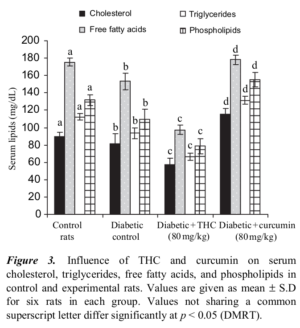
Meet Tetrahydrocurcumin: A precision-targeted, more bioavailable curcumin metabolite that is more white than yellow! You can get it from NNBNutrition.com
If there's one ingredient that's just as popular in the health-supplement scene as it is in the sports-supplement industry, it has to be curcumin! Although this ingredient isn't new, and it's been utilized in medicinal practices for centuries, research is finally starting to catch up and support once anecdotal claims surrounding curcumin's benefits.
Regardless of whether you're a bodybuilder, weekend warrior, marathon runner, or just a recreational lifter, it's well known that excessive amounts of inflammation can cause a lot of problems. Though, it's important to note that not all inflammation is bad. For example, lifting weights induces an inflammatory response in the muscles, which helps them repair and become stronger and bigger.
Another example is injuries. Inflammation is a key physiological process that must take place in order for an injury to heal properly. But, when your joints, tendons, or even your gut is chronically inflamed, that's when it's necessary to take action. While there are several ways to reduce inflammation, one of the most common is taking supplements that have potent anti-inflammatory effects. That brings us to curcumin.
Curcumin: Turmeric's Secret Weapon
Curcumin is an extremely popular ingredient in the supplement industry. It has a wide range of benefits, but it's primarily used for reducing inflammation. Curcumin is the main natural polyphenol present in turmeric -- a rhizomatous herbaceous plant in the ginger family.[1] It turns out that turmeric isn't just for adding flavor to food, it also packs a host of health benefits!
Historically, Curcuma longa (commonly known as turmeric) has been used to treat a variety of health conditions, thanks to its anti-inflammatory, antioxidant, antimicrobial, anticancer, and antimutagenic properties.[1] Turmeric's health benefits are primarily attributed to its curcumin content, which has been found to induce cellular activity and target specific signaling molecules.[1]
Curcumin's Downfall
Research shows that curcumin is beneficial for treating inflammatory conditions, metabolic syndrome, pain reduction, promoting kidney health, and helps manage degenerative eye diseases.[1] At this point you're probably wondering what's the catch...because curcumin just sounds too good to be true! Unfortunately, there's one caveat to curcumin and it's something that's incredibly important for any dietary supplement -- bioavailability.[1]

Also known as curcuma longa, turmeric is the root where we get curcumin - and ultimately tetrahydrocurcumin - from.
Despite curcumin's so-called superpowers, the body does not absorb it very well on its own when consumed orally. Studies have shown that curcumin suffers from rapid metabolism, poor uptake, and rapid elimination, leading to overall poor bioavailability.[1] In other words, instead of utilizing all the herb has to offer, your body just gets rid of it.
One of the ways to work around this issue is by improving absorption. To do that you combine curcumin with other ingredients, like piperine from black pepper extract, which some call a curcumin complex.[1] Now, there's a new ingredient on the block that may be a game changer when it comes to curcumin and its bioavailability issue!
CurcuPrime to the Rescue!
NNB Nutrition, a leader in ingredient research and development, is back again... this time, introducing a potentially superior form of curcumin. CurcuPrime is a trademarked form of tetrahydrocurcumin (4-HC), a natural metabolite of the herb. It's purported to have vastly better absorption, resulting in enhanced health benefits![2] Preliminary research suggests that tetrahydrocurcumin, compared to its curcumin counterpart, is a stronger antioxidant, more powerful blood glucose regulator, and is superior at optimizing blood lipid levels.[2]

NNB Nutrition's CurcuPrime is a purified tetrahydrocurcumin ingredient for the precision-targeted benefits discussed above - and it's non-staining!
Up to this point, supplement companies and contract manufacturers couldn't get their hands on this novel ingredient. If you want to experience the power of tetrahydrocurcumin, then we recommend picking up CurcuPrime.
As tetrahydrocurcumin becomes more popular, don't be surprised when other companies come along and use the generic forms and subpar dosages over a trademarked ingredient. Not all generic forms of supplement ingredients are low quality, but enough of them are, especially novel compounds that are difficult to source.
As more research and news comes out on CurcuPrime, this article will be updated, so make sure to subscribe below to receive notifications! If you want to learn more about tetrahydrocurcumin, check out this in-depth article, Tetrahydrocurcumin: A More Potent Alternative to Curcumin?
Subscribe to PricePlow's Newsletter and Alerts on These Topics
Tetrahydrocurcumin 101
Tetrahdyrocurcumin is a major metabolic constituent of curcumin and it's believed to be responsible for the compound's benefits. From a structural standpoint, tetrahydrocurcumin is very similar to curcumin, except it has four additional hydrogen atoms.[2,3] Another key difference is the color. Curcumin is known for having a bright goldish-orange tint, whereas tetrahydrocurcumin is colorless.[2,3]
This may not seem like a big deal, but for many supplement manufacturers and brands, it's huge. Turmeric's yellow pigment is notorious for staining fingers, clothes, walls, and anything else it touches. Interestingly, tetrahydrocurcumin was first discovered by researchers from the University of Sydney in Australia, who recorded it in scientific literature in 1978. It was coined "Curcumin's key bioactive metabolite."[4]
Studies note that compared to the other metabolites, tetrahydrocurcumin has some of the most potent biological activity. Tetrahydrocurcumin is also known for being more stable than curcumin because it has superior absorption and bioavailability properties. A 2014 research review from the University of Texas MD Anderson Cancer Center in Houston found that even without the presence of curcumin, tetrahydrocurcumin is stored in adipose tissue for four weeks after ingestion.[2] On that point alone, it looks like tetrahydrocurcumin is a better alternative to curcumin.
The Research on Tetrahydrocurcumin in CurcuPrime
As of writing this article, several studies have shown that CurcuPrime boasts potent antioxidant properties, promotes healthy blood glucose and blood lipid levels, and expresses the potential to support cardiovascular and liver health.[2]
-
Antioxidant Powerhouse
Multiple studies have shown that compared to curcumin, CurcuPrime is more water soluble. So it's better at reducing N2O-triggered HO-induced lipid peroxidation and copper induced oxidation of low density lipoprotein (LDL) cholesterol.[5,6]
Although LDL gets a bad reputation, it's really only problematic when levels are above normal and become oxidized (along with low levels of HDL and high triglyceride levels).[7,8] If taking CuruPrime can reduce some of this activity from occurring, it would be a major health benefit!A 2007 study published by researchers from Mahidol University in Thailand found that tetrahdyrocurcumin has higher levels of scavenging activity against the DPPH radical. It suggests that CurcuPrime's antioxidant activity gets stronger from hydrogenation.[9] At this point, there's a fair amount of evidence to support using CurcuPrime, opposed to standard curcumin, for improved antioxidant activity.Some research suggests that curcumin is better if you're looking for anti-inflammatory effects.[10,11] But that could change if more studies test that hypothesis. We expect that curcumin's bioavailability and absorption plays a large role in reducing inflammation. If that turns out to be the case, CurcuPrime would be more effective. Thus, if you're taking curcumin for its anti-inflammatory properties, be sure to pair it with black pepper extract (also known as BioPerine), or you're just wasting your time and money. -
Blood Glucose Regulator
There's also strong evidence to suggest CurcuPrime promotes healthy blood glucose levels.
Optimizing insulin sensitivity is crucial, regardless of your health and fitness goals -- whether its weight gain, loss, or just maintenance. Several health conditions are linked to insulin resistance, which is when the body doesn't respond to insulin like it should. Insulin is a hormone secreted by the pancreas. When carbs enter the bloodstream,insulin tells your cells to lower blood glucose levels. If you're insulin resistant, the pancreas still pumps out insulin, but your cells don't regulate blood glucose levels properly. It can cause hyperglycemia.
It's best to avoid that at all costs. Some of the ways to maintain or regain proper insulin sensitivity are by eating a diet that's well balanced, high in protein, and micronutrient-rich. It's also important to exercise regularly, and if you carry excess body fat above a healthy range, lose weight. Another thing you can do, on top of general lifestyle changes, is take supplements that have been shown to improve glycemic control. One of them is CurcuPrime.A 2006 study by researchers from Annamalai University in India found that diabetic mice that were dosed with 80mg/kg of tetrahydrocurcumin once a day for 45 days experienced reduced average blood sugar levels (18.2%) and increased plasma blood insulin levels (12.5%) compared to a group supplemented with curcumin![13]Previous studies found similar results as one cited below in which the authors theorized that tetrahydrocurcumin stimulates pancreatic beta cells, resulting in enhanced insulin secretion.[14] If you're familiar with the benefits of curcumin, then this may not be a surprise since many people take curcumin supplements for its blood glucose lowering effects.[15] However, if tetrahydrocurcumin is the primary constituent responsible for these benefits, then supplementing with that ingredient in isolation may be more effective in the long run. -
Encourages Healthy Blood Lipid Levels
If an ingredient positively affects blood glucose, it may have a favorable downstream effect on cholesterol levels as well. High cholesterol is closely linked to health problems caused by insulin resistance, such as type II diabetes. Following the 2006 study where Annamalai University researchers saw the way tetrahydrocurcumin significantly improved blood glucose and insulin secretion,[13] they assessed the compound's impact on lipid levels.
The researchers again gave diabetic mice tetrahydrocurcumin or standard curcumin and measured cholesterol levels, triglycerides, and phospholipids.The results showed that tetrahydrocurcumin supplementation led to significant decreases in cholesterol, free-form fatty acids, triglycerides, and LDL levels in serum and liver samples.[12]In addition, the study authors saw a slight increase in HDL cholesterol levels, which is commonly known as "good" cholesterol.[12] The tetrahydrocurcumin group outperformed curcumin again! This is a significant finding because not only can CurcuPrime lower overall cholesterol and triglyceride levels, it also promotes a healthy ratio of LDL to HDL,[12] which very few natural compounds are capable of!Healthy levels of cholesterol, triglycerides, and blood glucose are key to better cardiovascular health. -
Cardiovascular Benefits
A 2012 study published by the International Journal of Pharmacology assessed tetrahydrocurcumin's effects on aortic rings in mice and to see if the compound has cardio-protective properties.[16] First the researchers expanding aortic rings with Carbachol, a compound known for inducing vasodilation .[16] Then, the mice were given homocysteine thiolactone (HTL) to inhibit vasorelaxation.[16] Finally, the researchers gave the mice 10μM or 30μM of tetrahydrocurcumin and found that it induced vasorelaxation at a level similar to Carbachol.[16]
According to the study, HTL produced vasoconstriction by reducing the amount of nitric oxide levels in blood vessels and through increased free radical production.[16] Thus, tetrahydrocurcumin must affect either nitric oxide, free radical production, or both, in order to restore vasodilation. Knowing its strong antioxidant properties, it's possible that tetrahydrocurcumin scavenges free radicals.[16]
But why is this important?
In order to deliver blood flow more efficiently throughout the body, blood vessels must be able to vasodilate. Think about it this way: when you exercise and blood is carried to working muscles, the more oxygen and nutrients can be delivered.
This is why a lot of pre-workouts have ingredients that increase nitric oxide levels and induce vasodilation. But nitric oxide levels can also affect blood pressure. Although various things can cause high blood pressure, it's often a result of narrow blood vessels caused by excessive vasoconstriction.In a 2011 study, researchers from Khon Kaen University in Thailand gave mice tetrahdydrocurcumin to see its it affect on blood pressure.[17] To induce vascular dysfunction, the researchers utilized L-arginine methyl ester (L-NAME).[17] The mice were divided into three groups. Group one received L-NAME, group two were given tetrahydrocurcumin (50mg/kg of body weight) and L-NAME, and group three received tertahdyrocurcumin (100mg/kg of body weight of ) with L-NAME.[17]After three weeks of daily administration, the tetrahdyrocurcumin group had significantly reduced blood pressure compared to the L-NAME-only group.[17] The authors surmised the effect was dose dependent since the group give the higher dose experienced better results than the group given the lower dose.[17] The researchers credited the good results to tertrahydrocurcumin's ability to induce vasodilation.[17] -
Promotes Liver Health
The liver is a vital organ that's responsible for metabolizing drugs and detoxifying chemicals that enter the body. It essentially filters blood from the digestive tract before it circulates. The liver also secretes bile from the gallbladder and through the small intestine, which helps break down dietary fats.
In order to repair cellular injuries, the liver engages in a process called hepatic fibrogenesis. Although it's a completely normal function, when it's performed continuously in people with chronic liver injury, it can lead to liver failure or cirrhosis.[18]
The reason we bring this up is because a study published in 2018 found that tetrahydrocurcumin significantly decreases fibrogenesis and hepatic injury in vitro compared to curcumin.[7] The authors attributed this effect to tetrahydrocurcumin's ability to protect hepatocytes from apoptosis (programmed cell death), block fibrogenic signaling, and inhibit hepatic cell stimulation.[7] They suggested that just 50mg/kg of body weight or less of CurcuPrime could result in hepatoprotective effects.[7]
Our CurcuPrime Review and Discussion
Listen to Mike, founder of PricePlow, discussing his excellent experience with this underrated ingredient:
Dosing: Safety and Efficacy
Since tetrahydrocurcumin is a fairly new ingredient, a lot more research on humans is needed., It's difficult to pinpoint what an optimal dose should be. However, current studies can provide context for making an educated estimate.

Meet ZinjaBurn from NNB Nutrition. With a similar structure to curcumin, it has anti-inflammatory effects and better bioavailability.. but its effects skew towards weight loss related benefits!
Since anti-inflammatory effects were observed with dosages as low as 20mg/kg of body weight in mice and up to 80mg/kg of body weight resulted in other benefits, such as blood glucose-regulating, lipid-lowering, and radical-scavenging effects, we estimate that between 200mg to 800mg/day is sufficient for a individual who weighs 150 to 200 pounds.
It's important to note that the authors did not disclose the weight of the animals used in the studies, since supplement dosages depend on weight make sure to check back for updated information as more research comes out!
If you decide to try CurcuPrime, we recommend taking 200mg two times per day. It's OK to take it on an empty stomach. For blood glucose lowering effects, then take it before a meal that contains carbohydrates. One last thing to note is that dosages as high as 400mg/kg of body weight have been used in research with no adverse effects reported.[2]
As always, before using a new supplement, talk to a qualified healthcare professional.
The ultimate curcumin supplement?
Our final take? Looking at the literature comparing curcumin and tetrahydrocurcumin, combining them together seems like the best of both worlds, yielding the best benefits from two different sides.
Supplement formulators looking for a "next-level form of curcumin" for the customers should consider this strategy, and combine them with some black pepper extract for enhanced absorption of the standard curcumin.
NNB Nutrition Continues to Dominate Ingredient Development
Over the past few months, we've noticed NNB Nutrition getting ahead in the race to develop new trademarked ingredients. Companies and consumers recognize the value of branded ingredients, especially when designed by trusted sources. While there are several ingredient developers in the industry, NNB Nutrition is one of the elite.
They drive the industry forward by sourcing the highest quality compounds available. NNB Nutrition is also known for conducting cutting edge research. Thus, they're always two steps ahead of the competition. When you see NNB Nutrition come out with a new ingredient, you know that months of research, testing, and development went into its creation.

NNB Nutrition is an innovative ingredient development company with an elite team of over 100 scientists from over 10 countries.
NNB Nutrition is the company behind some of the hottest ingredients on the market, such as patent-pending MitoBurn, CaloriBurn, and patented GlucoVantage. CurcuPrime isone of the newest additions to the lineup, but there's a lot more to look forward to! Make sure to subscribe below so you don't miss what's next from NNB Nutrition!









Comments and Discussion (Powered by the PricePlow Forum)